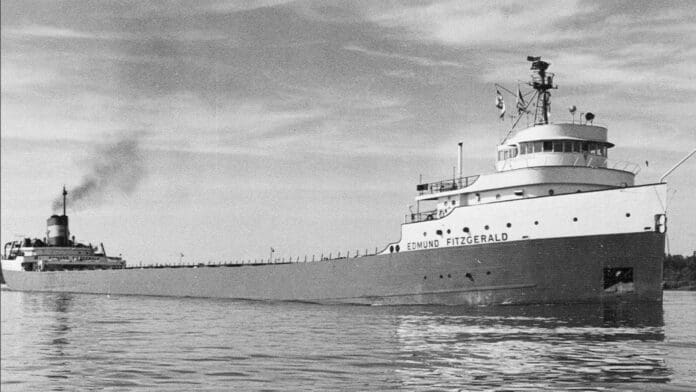November 9, 1975. The Edmund Fitzgerald departs from the Burlington Northern Railroad Dock No. 1 in Superior, Wisconsin. Captain Ernest M. McSorley has loaded her with 26,116 long tons of taconite pellets. Shortly after departing, the Edmund Fitzgerald is joined by the Arthur M. Anderson, which had left Two Harbors under Captain Bernie Cooper. The two ships are in radio contact. Because the Fitzgerald is faster, she takes the lead, the distance between the two vessels ranging from 10 to 15 miles.
A November storm builds, entering the Great Lakes from the great plains. Captain McSorley and Captain Cooper are aware of this. They agree to take the northerly course across Lake Superior, where they’ll be sheltered by highlands on the Canadian shore.
7 p.m. Gale warnings are issued. Weather conditions continue to deteriorate. Early in the morning on November 10, the gale warnings are updated to storm warnings. Winds gust to 50 knots. Seas are 12 to 16 feet. Both captains have piloted their ships in similar conditions before.
Early afternoon on November 10. The Fitzgerald passes Michipicoten Island and is approaching Caribou Island. The Anderson is just approaching Michipicoten. Captain Cooper watches the Fitzgerald pass too close to Six Fathom Shoal, north of Caribou Island. Snow and rising spray obscure the Fitzgerald from sight, seventeen miles ahead of the Anderson.
3:30 p.m. November 10. Captain McSorley radios Captain Cooper. “Anderson, this is the Fitzgerald. I have a fence rail down, two vents lost or damaged, and a list. I’m checking down. Will you stay by me till I get to Whitefish?” McSorley checks down his speed to allow the Anderson to close the distance between them.
5:20 p.m. The crest of a wave smashes the Anderson’s starboard lifeboat. Captain Cooper reports winds from the northwest by west at 58 knots, with gusts to 70 knots. Seas reach 18 to 25 feet.
6:55 p.m. Cooper and the men in the Anderson’s pilothouse feel a bump. The ship lurches, and they turn to see a monster wave engulf their entire vessel from astern. The wave works its way along the deck, crashing onto the back of the pilothouse, driving the bow of the ship into the sea.
“Then the Anderson just raised up and shook herself off of all that water – barrooff – just like a big dog. Another wave just like the first one or bigger hit us again. I watched those two waves head down the lake towards the Fitzgerald, and I think those were the two that sent her under.”
All 29 souls aboard the Edmund Fitzgerald perished with the ship.
Every November 10th, a memorial service is held for those 29 and the countless other souls claimed by the lake. This November 10th, the service was held at 4:15 p.m. The lighthouse, fog signal building, and visitor center were open, and visitors throughout the day could watch a film about the Edmund Fitzgerald, or join a guided tour exploring the history of the Fitzgerald’s final voyage. The lighthouse was temporarily closed at 4:15 while the names of the crew were read to the tolling of a ship’s bell, with a rendition of the Navy Hymn. The beacon was then lit, and the lighthouse was open to tour again until 6 p.m.
It was apropos then, that visitors during this year’s lighting braved rain and pea soup fog to attend. And that during the night of November 10, 2024, 49 years later after that fateful night of the Fitzgerald, gale warnings were issued along the North Shore with wind gusts of 50 miles per hour. A fitting and haunting reminder of the power of the storm that claimed the lives of those 29 men, as well as the lives of those in the other 49 shipwrecks that occurred along the North Shore of Lake Superior.



